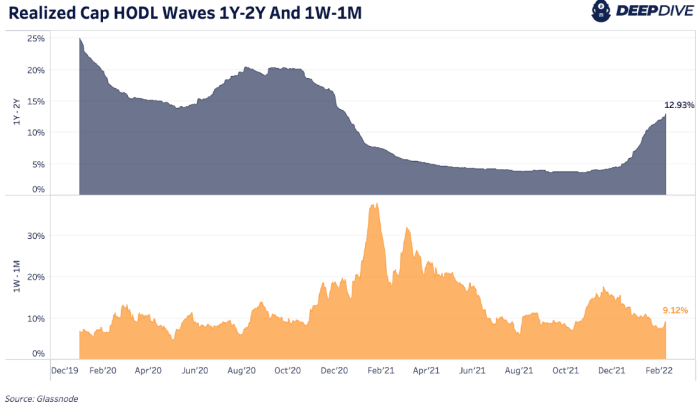The text below is from a recent edition of Deep Dive, Bitcoin Magazine’s premium markets newsletter. To be among the first to receive this information and other on-chain bitcoin market analysis straight to your inbox, Subscribe now.
A key on-chain metric that we have already discussed and will cover today is the realized HODL ratio (RHODL). The ratio uses realized HODL cap waves, which take the original HODL Wave metric and weight the UTXOs in each age bracket by their realized price. Specifically, the realized HODL ratio uses the Cap HODL age ranges of one week and one to two years.
For a more in-depth look at this metric, check out The Daily Dive: HODL Waves And Realized HODL Ratio.
By using this metric, we can better understand what is happening with younger coins versus older coins. As younger coins become more dominant and the ratio increases, long-term holders hold less of the realized market value. As the ratio decreases, long-term holders hold more realized market value than younger coins. An overheated market would show a much higher dominance of younger coins.
In previous bitcoin highs in 2021, we have not seen the rise of younger coins versus older coins like in previous cycles. We have seen the RHODL ratio increase throughout the year, but it has never been heated or overheated like the 2016 cycle. This could be due to a changing cycle, a more mature market or the fact that we are not haven’t seen the large wave of new demand, buying younger coins, seen in past cycles.
Over the past month, we have seen a significant increase in the HODL Waves and Realized Cap HODL Waves age brackets from one to two years old. More and more coins age into this band and take on more economic weight in the calculation of the RHODL ratio as long-term held supply enters the market. As a result, the RHODL ratio is around its 50th percentile between a neutral and cooled state.
Historically, we’ve seen the one-to-two year age bracket peak around 50% of supply, while it currently sits at 12.93%. We seem to be heading for a trend of increasing holder accumulation after a local bitcoin price top. As accumulation continues and older coins age, the RHODL ratio drops and makes bitcoin a more attractive historical buy.

